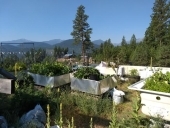
 20
20






![Filename: crinckle-crankle-bed.png
Description: [Thumbnail for crinckle-crankle-bed.png]](/t/178447/a/174421/crinckle-crankle-bed.png)
Be the shenanigans
you want to see in the world.


 6
6




How Permies works: https://permies.com/wiki/34193/permies-works-links-threads
My projects on Skye: The tree field, Growing and landracing, perennial polycultures, "Don't dream it - be it! "
 6
6





Invasive plants are Earth's way of insisting we notice her medicines. Stephen Herrod Buhner
Everyone learns what works by learning what doesn't work. Stephen Herrod Buhner
 5
5




Argue for your limitations and they are yours forever.
 12
12




"We carry a new world here, in our hearts..." --Buenaventura Durruti
"Don't wish it were easier. Instead, wish you were better." --Jim Rohn
 10
10




"You must be the change you want to see in the world." "First they ignore you, then they laugh at you, then they fight you, then you win." --Mahatma Gandhi
"Preach the Gospel always, and if necessary, use words." --Francis of Assisi.
"Family farms work when the whole family works the farm." -- Adam Klaus
 7
7




Zone 6, 45 inches precipitation, hard clay soil




 6
6




 7
7




R Scott wrote:At MSRP they may be pricey, but something to look out for when you see a bargain. I have seen window wells on clearance for a buck because they were damaged. A whole pallet of them. I would have bought them if I would have thought of raised beds.
 5
5




 6
6




 5
5




 1
1




craig howard wrote:I'm not sure those curvy brick walls could handle dirt piled up behind them.
Seems like it could cause them to expand and crack.
peace
brian
 3
3




 1
1




Marjorie Vogel wrote:What a timely post! I had an idea the other day and have yet to experiment with it.
I've been picking up the sections of an old concrete silo from the farm my husband works at. I would put five in the back of our SUV when I dropped him off each morning and now have a nice stack that I knew would someday be useful. Each piece is 2' wide and 3 1/2' long. They are corrugated, formed concrete with tongue and groove channels on all sides. They are meant to interlock in a circle, and then be stacked. The silo itself has metal bands every four courses to hold it together. Of course a silo holds all the weight inside. I know I can make round raised garden beds from one course. I'm wondering if I could make this kind of wall for a bed and just secure it by partially burying it?
 2
2








 1
1




K Eilander wrote:I recently spied this image on pinterest where they used corrugated metal window wells for raised beds in a geodesic greenhouse.

(For those who don't live areas where basements are common, those are intended to go flat against the foundation of a house and provide a gap for the basement windows to be.)
Not a bad idea for raised beds, because those things are designed to be buried and I'm sure will last a long time.
After all, the material is about the same as the prefabricated metal beds people do all the time - only in a potentially more versitile form.
Then I got to thinking of the British crinkle-crankle walls (wikipedia).

More examples on barnorama: https://www.barnorama.com/15-examples-of-weird-british-wavy-brick-walls/
If one metal section curved outward like in the original pic above, the next could be bolted on to curve inward. Add a parallel copy of the same thing an arms reach away and fill in between with logs+dirt. In this way you could design a modular bolt-together raised bed as long as you want!
Making a squiggly raised bed like this would:
1) maximize "the edge" (as in the permaculture design principle)
2) use the minimum amount of bricks (if built with bricks instead of the metal)
3) be less prone to bowing or bursting like the sides of straight-edged beds
4) provide a series of mini sun-traps on the sunward side
Thoughts?
Gemma Boyd
https://gemmaboyd.space/
https://www.instagram.com/gemmaboyd407/?hl=en

|
Forget this weirdo. You guys wanna see something really neat? I just have to take off my shoe .... (hint: it's a tiny ad)
Learn Permaculture through a little hard work
https://wheaton-labs.com/bootcamp
|







